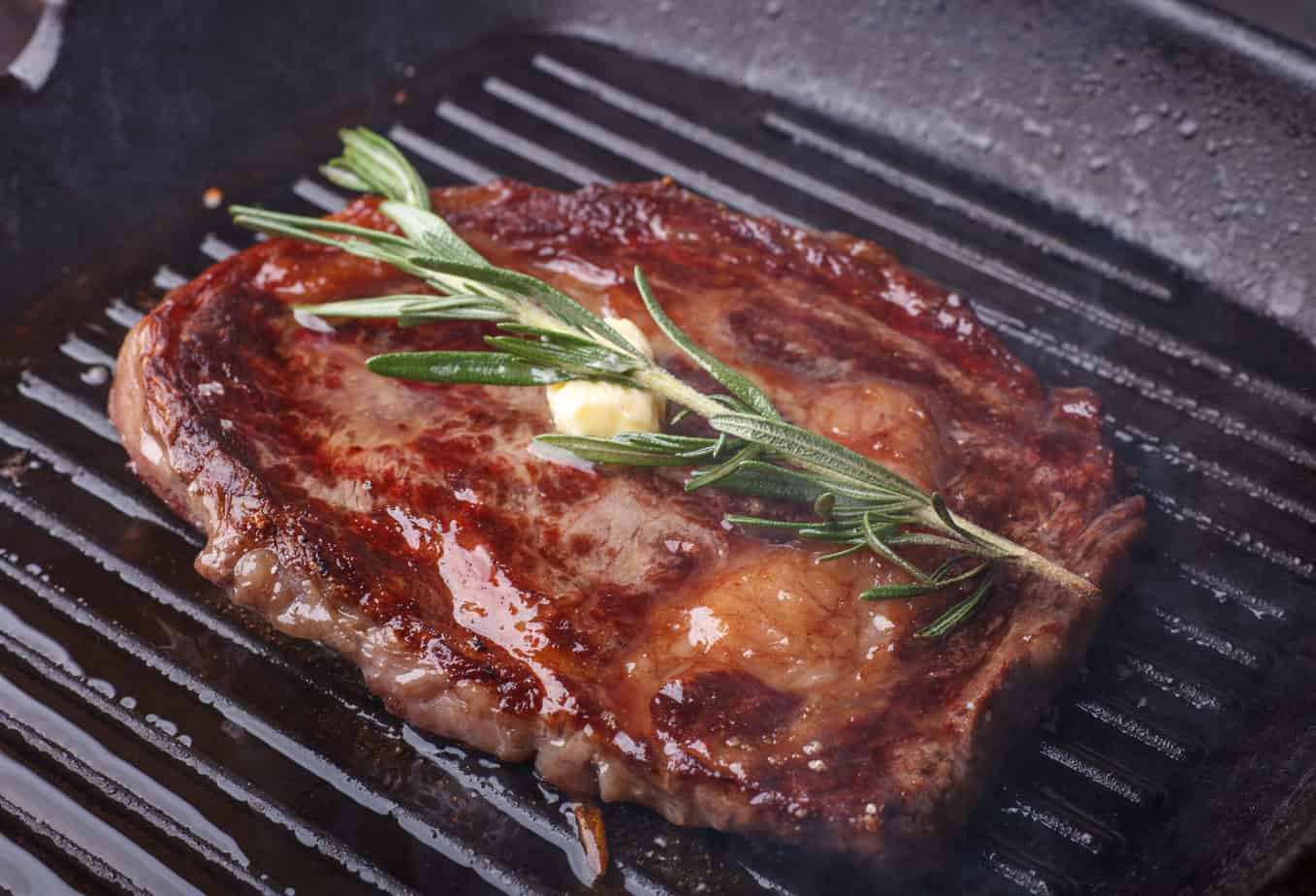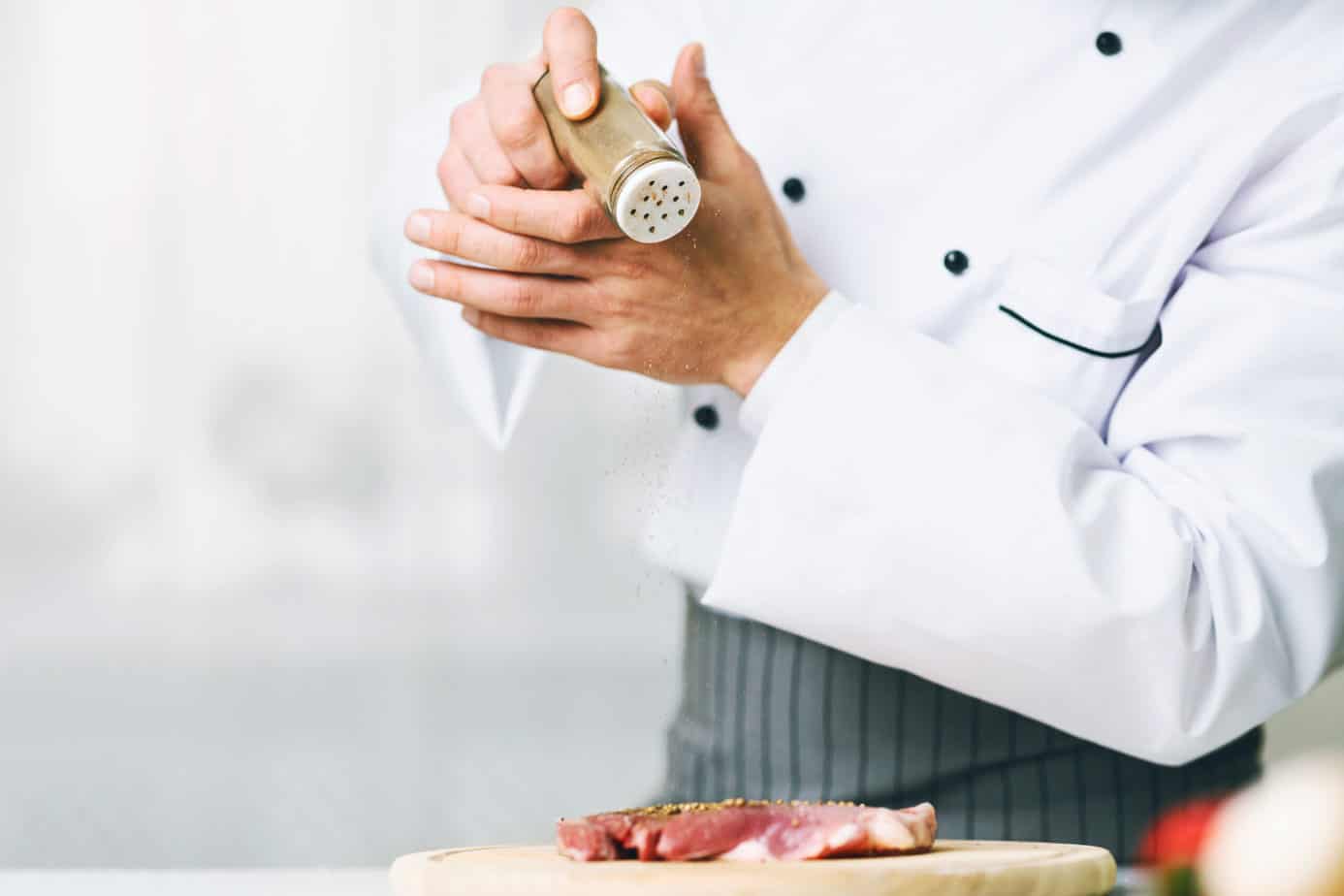- Ribeye vs Sirloin: Our Full Guide - April 7, 2022
- Traeger vs Weber Grills Brand Comparison: Choose The Best! - April 7, 2022
- Ooni Karu Review: Is It Worth It? - April 4, 2022
Everyone knows that butter makes food better. What everyone doesn’t know is that butter makes aging steak better. Hands down!
Butter aging steak brings out a flavor that you wouldn’t think possible if you were dry aging the same steak. So how do you butter age your steaks? Read on to learn more!
Butter Aged Steak Buying Guide: What To Consider
It is not easy to find butter-aged steak because it demands time and expertise. Few supermarkets carry USDA Prime beef or butter aged steak. It’s almost impossible for some Americans to get their hands on butter-aged steak from a local retailer.
Given the high cost associated with the butter-aged steak, the majority of consumers want to make sure they are getting value for their money. The following criteria should be kept in mind any time you go shopping for butter-aged steaks. You can apply the same for dry aged steak.
Find the best meat for your butter-aged steak at Fossil Farms - they specialize in providing the highest quality farm-raised game and all-natural meats in the country.
USDA Prime Shield
Go for products with the USDA Prime shield. The most important mark of superior beef in the United States is the USDA’s Prime rating.
Apart from having exceptional flavor and tenderness, beef rated by USDA has abundant marbling.
Marbling is the white and intramuscular fat that melts into beef cuts when you cook them. It bastes beef fibers with smooth and buttery goodness.
Get a Superior Cut of Meat
Dry aging beef can never change an inferior cut of beef to a better one so don’t get thrown off by the “aged beef” label. It’s about the cuts.
When it comes to gourmet butter aged steaks you need tenderloins, T-bones, porterhouses, NY strips, and Ribeyes for the perfect steak.
Such cuts are known to be the best for butter aging. They are renowned for superior marbling, flavor, and/or tenderness.
Determine the Aging Duration
Decide the duration you want your steaks to age. It’s crucial to know how long you would like your steaks to be aged. This is why you need to ask the seller how long they age the steaks.
If you are trying butter-aged steak for the first time, go for steaks that have been aged for no more than six weeks. This will let you determine if you like such dry aged steaks or not.

Trusted Seller of Dry Aged Beef
Always go for a trusted seller. It isn’t easy to determine if a seller is trusted or not. Some retailers are known to mislabel butter-aged steaks with wet-aged (wet aging process) or dry-aged (dry aging process) steaks in a bid to trick consumers. Some use their “rating systems” to bypass the quality control systems used by the USDA.
Get recommendations from family members, colleagues, or friends of a local butcher who sells butter-aged steaks. Since it may not be easy to find such a butcher in your locality, you should consider shopping online.
In this case, make sure to look at ratings and reviews from previous clients before you buy. If you can’t find the steaks anywhere, you can try aging them on your own using the information below.
Some Trusted Sellers I Recommend for Ordering Online (great cuts for dry aging):
Best Steak Cuts for Aging
When it comes to butter aging steak, you need to look for the best steaks. The best cuts include, but are not limited to:
- Rib roast (bone-in) or prime rib
- Porterhouse
- Rib steak (at least 3 ribs)
- Top butt (sirloin)
- Boneless ribeye (ribeye)
- Strip loin (New York Strip)
Choosing Butter for Butter Aged Steak
We all have our favorites when it comes to baking or cooking with butter. When it comes to butter aging steak, the type of butter you choose matters. You should decide between unsalted and salted butter. So what is the difference?
Unsalted vs. Salted Butter
Salt is the major difference between these two types of butter. Salted butter has some salt added. The amount of salt added from one brand to another varies. Unsalted butter is all cream.
Since salt is a preservative, salted butter has a longer shelf life compared to unsalted butter. Unsalted butter can last up to 3 months while salted butter lasts about up to 5 months in the fridge. Additionally, you have a higher chance of getting fresh butter from the supermarket if you go for salted butter.
When to Use Each Kind
It all depends on your preferences. However, if a recipe specifies one type of butter, use it. If the recipe does not specify, the following guidelines can be used to determine the type of butter you should use.

Unsalted Butter Use
Unsalted butter is most commonly used in baking recipes. For butter aging steak, it is only recommended if you limit salt for health reasons. Unsalted butter has a creamy and neutral flavor.
In butter aging steak, precise measurements are the key to achieving the right texture and flavor. The same case applies to baking. Unfortunately, you can’t be sure of the exact quantity of salt in your salted butter. For example, baking recipes are typically formulated with unsalted butter in mind. This is why you are required to use a specific measure of salt.
This means it doesn’t matter the brand of butter you use. Unsalted butter ensures the recipe works as intended. If you are butter aging steak and the recipe doesn’t specify the type of butter to use, the best option is using unsalted butter.
Salted Butter Use
There are many uses for salted butter in the kitchen. Since salt helps bring out the flavor in foods, it is also a good choice for butter aging steak.
When composing toppings for your morning toast, sautéing veggies, composing sauces, or making your Thanksgiving turkey, use salted butter. The same case applies when you are butter aging steak.
The touch of salt in butter helps accentuate the flavors in your steak. Unsalted butter may provide the touch of butter needed for aging steak, but it will not enhance the flavor of steak as well. You can also use salted butter as a spread or in any savory application.
Which is Better: Salted or Unsalted?
There is not butter that is better than the other between unsalted and salted butter. Both unsalted and unsalted versions are useful in butter aging steak.
They are both delicious and make for a rich and delectable steak. However, the salted option gives you more flavor.

Butter Aging Ribeye Steak Process
Take note this is a 60-day butter aging process. The good news is you can do this at home with any refrigerator that meets the requirements. Here we go…
Ingredients
- Minced garlic
- Thyme
- Rosemary
- 6 blocks of room temperature butter
- A piece of full ribeye steak
What You Will Need
The following items are paramount if you are to successfully butter age your ribeye. You can get them from your local store or favorite online store.
- Apron
- Cutting board
- Cast iron skillet
- Vacuum sealer
- Butcher’s knife
- Tray with a metal rack
- Refrigerator
- Gloves
- Deep pan
Instructions
Use the following steps accurately to ensure you get optimal results:
Step 1: Preparing the Steak
Place your steak in the deep pan. Wear your gloves and start coating the steak with butter. Ideally, you need to ensure the entire steak is covered with butter. The result should be a butter layer on the steak.

Step 2: The Refrigeration
This is the simplest step. Place your buttered steak in the refrigerator for 60 days. If you wanted to keep some for future indulgence, slice off a piece. Place it in a bag and vacuum seal. This ensures you can enjoy the same flavors soon.
Step 3: Cooking
You can cook a butter-aged ribeye using two methods. You can start by sous vide and follow by pan searing. Alternatively, you can just pan-sear it. It all depends on your preferences. Some people prefer the sous vide version because according to them, it makes the whole steak taste better. We recommend you cook two steaks using either method to determine your preference.
Sous Vide Ribeye Butter Aged Steak
The following steps show you how to cook your butter aged ribeye Sous Vide:
Step 1: Preparation
Let the steak rest after you remove it from your fridge. It may take an hour or more before it reaches room temperature. Don’t move to the next step before your steak reaches room temperature.
Step 2: Sous Vide Preparation
Fill up a large pot to at least 2/3 of its size with water. Now bring the sous vide to 125°F.
Step 3: The Steak
Place your steak in the sous vide and let it rest for about an hour on the minimum. For the best result, let it rest for about 3 hours.
Step 4: Cooking Preparation
Get your cast-iron skillet and bring it to medium-high. You can put the extra butter aside using a bowl. Use a cutting board to place your steak so you can season it with black pepper and salt.
Step 5: Pan Searing
Now you can start pan-searing. Make sure each side of your steak is pan-seared for 2 minutes. You can add the garlic, rosemary, and butter at the last minute of searing each side. Remember a large spoon is the best tool to ladle the butter over the top of each side of your steak.

Step 5: Finishing Up
Once your steak has reached your preferred doneness, you can let it rest for 5 – 10 minutes on your cutting board. This ensures the juices don’t squirt when you are cutting your steak. Enjoy!
Pan Searing Ribeye Butter Aged Steak
The following process is about pan-searing butter aged ribeye steak using only the pan-seared method.
Step 1: Preparation
Get the steak from the refrigerator. It may need to rest for an hour or more before the ribeye reaches room temperature. Always ensure your butter-aged steak is at room temperature before you start prepping and cooking.
Step 2: Oven/Skillet Preparation
Heat your oven to about 350°F. At the same time make sure you are heating your skillet at medium heat.
Step 3: Seasoning the Steak
Season your butter-aged ribeye with pepper and salt on a cutting board.

Step 4 Pan Searing
Start to pan sear the ribeye on each side until blackened or for 2 minutes. Use the same process above for sous vide/pan searing for adding thyme, rosemary, garlic, and butter. Remember for this step you also need a large spoon to ladle the melted butter.
Step 5: Oven Cooking
Now place the steak in the oven until it reaches about 145°F if you are looking for medium-rare.
Step 6: Finishing Up
Once your butter-aged ribeye steak is ready, let it rest. The move makes sure you don’t splatter the steak’s juices as you cut it. Enjoy!
The Do’s and Don’ts of Butter Aging Steak at Home
Aging steaks at home is not a daunting process. However, there are some dos and don’ts you need to know about before you go about the process. These will ensure you avoid making mistakes that won’t give you the outcome you desired.
The Dos
Try and find out the difference between foul and funky. Some common sense needs to be applied here. You also need to understand the difference in smell between a steak that has gone rancid and one that is heavily aged.
A heavily dry-aged or butter-aged steak may give off a weird smell such as blue cheese. This smell is not unpleasant. The other can make you recoil in disgust. Avoid consuming the latter as it will cause serious health problems.
Try and use whole muscles such as sub-primal and steaks. Ribeye is a good choice for butter aging steak.

The Don’ts
Never use a non-dedicated fridge. If you use a small fridge like the one in your office for butter aging steak, you are guaranteed devastating results. The reason is a public or normal fridge is opened at least 20 times a day. Additionally, it has a variety of questionable sealed foods.
Household fridges are usually warmer than the recommended safe temperature of 40 degrees Fahrenheit. It is the result of doors being opened and closed frequently combined with inaccurate thermostats. Other items stored in such a fridge affect the flavor of your butter-aged meat.
Never use the butter aging fridge for storing any other items. It should be solely used to store your butter-aged steaks. Apart from interfering with your meat’s flavor as mentioned above, you risk cross-contamination of flavor profiles. This may result in the wrong and at times disgusting flavors you didn’t expect.
Don’t rinse, wash, or season your meat before butter aging. Save the seasoning until you are ready to cook the steaks. This way, you will get the best flavors associated with butter aging.
Butter Aged Steak FAQs
Answer: The duration of butter aging steak varies with your preferences. Ideally, a minimum of 30 days is required for the butter to combine its flavors with your steak. As long as you follow one of the two processes above, you should get the best outcome in 30 – 60 days.
Answer: The meat doesn’t spoil when you age is because of the conditions that ensure the levels of bacteria and moisture are controlled. Moisture is drawn out of the steak during the butter aging process. This ensures the dry aged beef flavor increases and becomes “beefier”.
Answer: Decidedly beefy, similar to rare roast beef, is the taste to expect from any butter-aged steak. Additionally, there are subtler hints of other delicious flavors. They include warm buttered popcorn and enhanced flavors of the steak you have butter aged.
Answer: Yes! As long as you follow the butter aging process to the letter, it should be safe. Additionally, make sure you maintain the same temperature in your refrigerator during the butter aging process.
Question: How Long Can You Let Butter Aged Steak Sit in the Fridge?
Answer: Generally 5-7 days is the maximum time you should let a steak sit in the fridge without any additional treatment like wrapping or butter encasing. Before placing in the fridge, check that the fridge thermometer reads below 40 degrees. Many household fridges are NOT by default set below 40.
Question: How Do You Age a Steak Without it Going Bad?
Answer: First, ensure your steak is wrapped in parchment or butcher block paper. Then, place the wrapped package in a fridge set to a temperature for 36 degrees. Keep the wrapped cut undisturbed in the fridge for 7-10 days (no more than 2 weeks unless you know what you are doing). Upon removing from the fridge, cut the dried out layers off the exterior of the meat. Cook to perfection!
Bottom Line on Butter Aged Steak
You can decide to buy butter-aged steak or age them on your own. Either way, always remember a prime cut of beef or steak is the best place to start. Additionally, the aging duration determines the taste and flavor you get from the aging process.
A dedicated refrigerator is crucial to ensure the best results. Flavors from other foods may affect the flavor of your steak should you use a public or home refrigerator.
Find the best meat for your butter-aged steak at Fossil Farms - they specialize in providing the highest quality farm-raised game and all-natural meats in the country.


